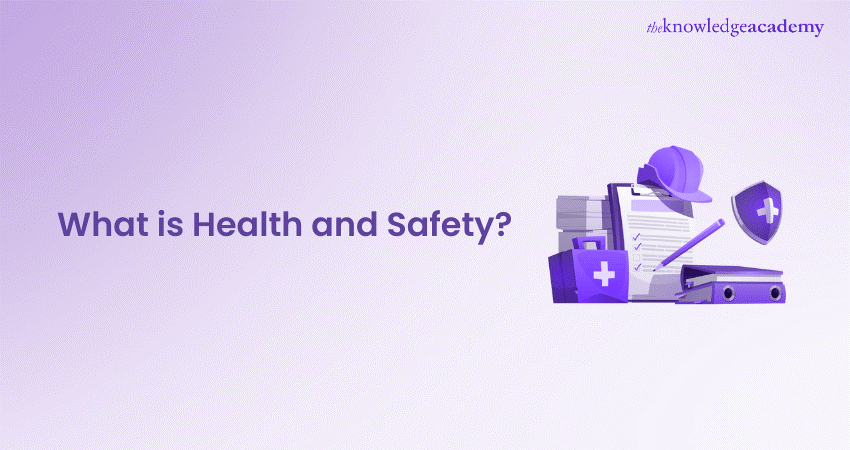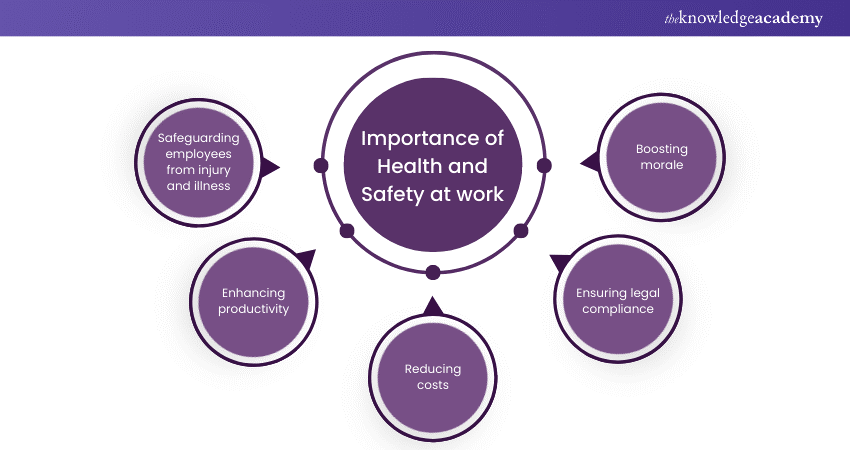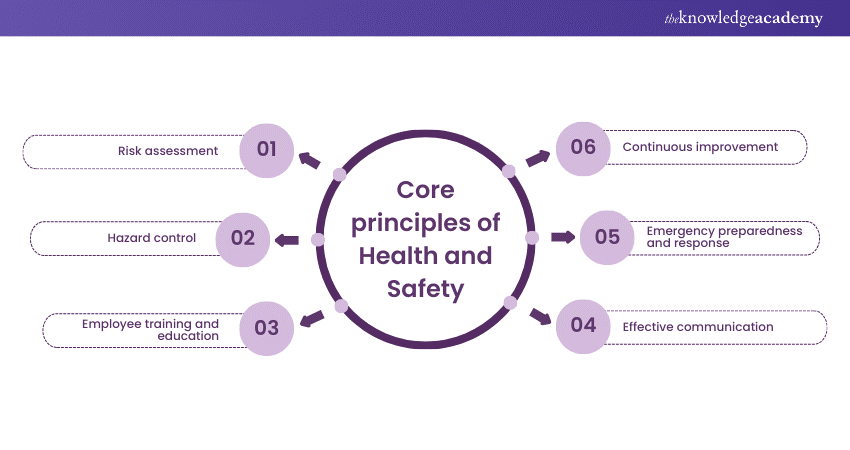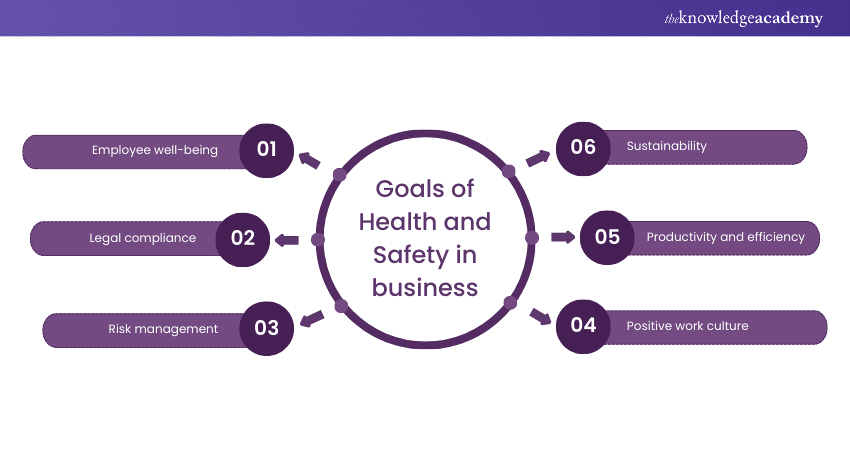We may not have the course you’re looking for. If you enquire or give us a call on 01344203999 and speak to our training experts, we may still be able to help with your training requirements.
Training Outcomes Within Your Budget!
We ensure quality, budget-alignment, and timely delivery by our expert instructors.

When we ask, "What is Health and Safety in the workplace?" we’re referring to the shield that guards the vitality of our workforce. It’s a comprehensive term encompassing businesses' strategies, standards, and practices to minimise risks and protect their employees from harm. It’s about creating a culture of safety in every action and decision. This blog will give an in-depth explanation of Health and Safety.
Table of Contents
1) Understanding What is Health and Safety
2) What is a Health and Safety Executive (HSE)?
3) Importance of Health and Safety at work
4) Core principles of Health and Safety
5) Goals of Health and Safety in business
6) Deciphering OHS: Occupational Safety and Health
7) Role of Health and Safety organisations, regulations, and guidelines
8) Conclusion
Understanding What is Health and Safety?
Health and Safety are multifaceted concepts encompassing a wide range of principles, practices, and regulations to protect individuals from harm in various environments, particularly workplaces. At its core, Health and Safety involve:
a) Identifying potential hazards
b) Assessing risks
c) Implementing control measures
d) Promoting a culture of safety to prevent accidents, injuries, and illnesses
It's about creating environments where individuals can work, live, and interact without fear of harm or injury.
In the workplace, Health and Safety measures may include:
a) Conducting risk assessments
b) Providing training and education on safety protocols
c) Implementing engineering controls to eliminate hazards
d) Ensuring compliance with relevant regulations
By prioritising Health and Safety, organisations can create safer work environments, protect their employees, and mitigate risks associated with accidents and injuries.
What Is a Health and Safety Executive (HSE)?
The Health and Safety Executive (HSE) is an autonomous regulatory body in the UK tasked with overseeing and enforcing workplace Health and Safety regulations. It aims to prevent work-related fatalities, injuries, and health issues by fostering and regulating a safe and healthy work environment.
The HSE cultivates a workplace culture of Health and Safety by collaborating with employers, workers, and various stakeholders. It offers enterprises advice and guidelines, conducts inspections and probes to verify adherence to Health and Safety statutes, and implements necessary enforcement actions.
The HSE is responsible for upholding various Health and Safety laws, notably the Health and Safety at Work Act of 1974 and the Management of Health and Safety at Work Regulations of 1999. It provides targeted guidance and support for specific sectors and hazards, including construction, chemical handling, and workplace transportation.
The HSE’s role is crucial in safeguarding UK workers’ welfare and is recognised for effectively enforcing Health and Safety regulations. It is essential in ensuring worker protection and advocating for secure occupational practices across various industries.
The principal duties of the HSE department are:
a) Formulating and executing Health and Safety strategies and protocols
b) Performing risk evaluations and audits
c) Investigating incidents and mishaps
d) Delivering instruction and advice on Health and Safety matters
e) Ensuring observance of Health and Safety laws
Transform your workplace into a safer and healthier environment with our comprehensive Healthy Working Environment Training. Elevate safety and boost productivity – Join now!
Importance of Health and Safety at work
The importance of Health and Safety at work cannot be overstated. Beyond the ethical imperative of protecting employees, there are several tangible benefits that businesses stand to gain from prioritising Health and Safety:

1) Safeguarding employees from injury and illness
The foremost importance of Health and Safety at work lies in its ability to protect employees from potential hazards, thereby safeguarding their physical well-being. By implementing proactive measures such as risk assessments, hazard controls, and safety protocols, organisations can minimise the risk of accidents, injuries, and illnesses in the workplace.
It not only preserves the Health and Safety of employees but also fosters a culture of trust and confidence where individuals feel valued and supported by their employers.
2) Enhancing productivity
A safe and healthy work environment is inherently conducive to higher productivity levels. Employees who feel secure in their surroundings can better focus on their tasks and perform optimally. Conversely, workplaces rife with hazards and safety concerns can lead to distractions, absenteeism, and decreased productivity. Investing in Health and Safety initiatives can create conditions that promote employee well-being and productivity, driving overall operational efficiency and performance.
3) Reducing costs
While some may view Health and Safety initiatives as an added expense, they are a prudent investment that can yield substantial cost savings in the long run. Organisations can avoid the financial burdens associated with medical costs, workers' compensation claims, legal liabilities, and potential regulatory fines by preventing workplace accidents, injuries, and illnesses.
Furthermore, a safer work environment can lead to lower insurance premiums, reduced absenteeism, and improved employee retention, all contributing to significant cost reductions over time.
4) Ensuring legal compliance
Compliance with safety and health regulations is not just a legal requirement but also an important obligation for organisations committed to ethical and responsible business practices. Failure to adhere to applicable standards and laws can result in severe consequences, including fines, penalties, lawsuits, and reputational damage.
By proactively addressing Health and Safety concerns, organisations demonstrate their commitment to meeting their legal obligations, protecting their employees, and upholding the integrity of their operations.
5) Boosting morale
A strong emphasis on Health and Safety can positively impact employee morale and engagement. Employees who perceive that their employers value and prioritise their well-being are more likely to feel motivated, satisfied, and invested in their work.
A safe and supportive work environment fosters employees' sense of loyalty and belonging, leading to higher job satisfaction, lower turnover rates, and enhanced organisational culture. Ultimately, by prioritising Health and Safety, organisations can cultivate a workplace where employees feel respected, valued, and empowered to contribute to the success of an organisation.
Elevate your team's safety standards – Join our Health and Safety Training for Managers and Supervisors Course today!
Core principles of Health and Safety
The core Health and Safety principles serve as the foundation for effective risk management and accident prevention. These principles include:

a) Risk assessment: Identifying and evaluating potential hazards to determine the level of risk and implementing appropriate control measures to mitigate risks. Risk assessment involves analysing the likelihood and severity of potential hazards and taking steps to minimise their impact on employees and the organisation.
b) Hazard control: Implementing measures to eliminate or minimise hazards through engineering controls, administrative controls, and personal protective equipment. Hazard control involves identifying the root causes of hazards and implementing solutions to prevent accidents and injuries.
c) Employee training and education: Equipping workers with the necessary knowledge and competencies to recognise hazards, adhere to safety procedures, and effectively handle emergencies is crucial. Employee training and education play an important role in increasing awareness of Health and Safety concerns, as well as ensuring that workers possess the capabilities and confidence to execute their duties safely.
d) Effective communication: Ensuring that Health and Safety information is communicated clearly and effectively throughout the organisation, fostering a culture of awareness and accountability. Effective communication involves sharing information about hazards, safety procedures, and emergency protocols with employees, supervisors, and other stakeholders.
e) Emergency preparedness and response: Developing and implementing plans and procedures to handle emergencies effectively, minimising their impact on employees and operations. Emergency preparedness involves identifying potential emergencies, developing response plans, and training employees to respond quickly and effectively in crises.
f) Continuous improvement: Committing to ongoing review, evaluation, and enhancement of Health and Safety practices to adapt to evolving risks and challenges. Continuous improvement involves monitoring performance, identifying areas for improvement, and implementing changes to prevent accidents and injuries from occurring in the future.
Goals of Health and Safety in business
Health and Safety goals in business are multifaceted, encompassing various objectives aimed at protecting employees, ensuring legal compliance, minimising risks, and promoting a positive work culture. Some of the key goals include:

a) Employee well-being: Prioritising employees' physical, mental, and emotional health to create a supportive and safe work environment where individuals can thrive and excel.
b) Legal compliance: Ensuring compliance with Health and Safety regulations to avoid penalties, fines, and legal liabilities and shows a commitment to ethical business practices.
c) Risk management: Minimising risks and hazards in the workplace to protect employees and prevent accidents, injuries, and illnesses from occurring.
d) Positive work culture: Promoting a work culture characterised by trust, collaboration, and mutual respect, enhancing employee engagement, satisfaction, and retention.
e) Productivity and efficiency: Enhancing productivity and efficiency through safe work practices, ergonomic design, and effective risk management strategies that minimise downtime and maximise output.
f) Sustainability: Building a resilient and sustainable business by prioritising Health and Safety, protecting employees, and contributing to the well-being of society as a whole.
Enhance workplace safety with our IOSH Managing Safely Course and equip yourself with essential skills to manage risks effectively.
Deciphering OHS: Occupational Safety and Health
Occupational Safety and Health (OSH), also known as Occupational Health and Safety (OHS) or Work-Related Health and Safety (WHS), is a multidisciplinary domain dedicated to the well-being, safety, and welfare of individuals in the workplace. The term also encapsulates the goals of this field, which, in some contexts, is synonymous with the department responsible for implementing OSH measures.
The core aim of OSH programs is to foster a work environment that prioritises the Health and Safety of employees. These programs are designed to protect not only the workers but also their colleagues, families, customers, and anyone affected by the workplace environment. In the United States, the scope of OSH extends beyond occupational settings to include non-work-related activities, ensuring a comprehensive approach to Health and Safety.
The World Health Organization (WHO) defines occupational health as encompassing all aspects of Health and Safety in the workplace, emphasising hazard prevention. In this context,
Health is commonly interpreted as encompassing total well-being, including physical, mental, and social dimensions, rather than solely the absence of illness. Thus, occupational health is a multidisciplinary field dedicated to optimising job performance while minimising health risks, promoting a proactive stance towards workplace Health and Safety, and preventing injuries from potential workplace hazards.
Gain globally recognised qualifications to excel in occupational safety and risk management with our NEBOSH Courses. Sign up now!
Role of Health and Safety organisations, regulations, and guidelines
Health and Safety entities, along with the regulations and guidelines they establish, play a pivotal role in upholding standards and advocating for exemplary practices within workplaces and other settings. Here are the essential functions they serve:
a) Developing and Advocating for Health and Safety Standards: Organisations like the UK’s Health and Safety Executive (HSE) and the US’s Occupational Safety and Health Administration (OSHA) are instrumental in formulating and endorsing rules and guidelines aimed at shielding employees and the public from workplace hazards and risks.
b) Upholding Health and Safety Norms: These organisations also enforce Health and Safety standards. They perform inspections, investigations, and audits to ensure compliance with the established Health and Safety regulations and guidelines.
c) Offering Expertise and Counsel: They also dispense expertise and counsel to companies, institutions, and individuals to aid their understanding and adherence to Health and Safety regulations and guidelines. This support encompasses insights on best practices, educational programs, and additional resources that contribute to the prevention of workplace mishaps and injuries.
d) Fostering Consciousness and Instruction: A crucial aspect of these organisations’ work is fostering Health and Safety education. They initiate and administer educational programs, awareness drives, and other endeavours to elevate the understanding of potential dangers and risks, promoting preventive measures against workplace accidents and injuries.
Enhance your understanding of occupational health and safety regulations with our Best Practice in Occupational Health and Safety Regulation Training.
Conclusion
In essence, “What is Health and Safety?” encapsulates the commitment to safeguarding the workforce. This blog serves as a beacon, guiding readers through the principles and practices that underpin a secure and thriving workplace, emphasising the collective responsibility to uphold these standards.
Elevate your leadership skills and enhance Workplace Safety with our NEBOSH HSE Certificate in Health and Safety Leadership Excellence Training. Join today!
Frequently Asked Questions

Under Health and Safety legislation, your main responsibilities include ensuring a safe work environment, preventing injuries, providing training, and maintaining safe equipment. You must also protect not just employees but also anyone affected by work activities.

After an accident or Health and Safety incident, you should secure the area, provide immediate care, notify relevant parties, investigate the cause, and report the incident to comply with legal requirements.

The Knowledge Academy takes global learning to new heights, offering over 30,000 online courses across 490+ locations in 220 countries. This expansive reach ensures accessibility and convenience for learners worldwide.
Alongside our diverse Online Course Catalogue, encompassing 17 major categories, we go the extra mile by providing a plethora of free educational Online Resources like News updates, Blogs, videos, webinars, and interview questions. Tailoring learning experiences further, professionals can maximise value with customisable Course Bundles of TKA.

The Knowledge Academy’s Knowledge Pass, a prepaid voucher, adds another layer of flexibility, allowing course bookings over a 12-month period. Join us on a journey where education knows no bounds.

The Knowledge Academy offers various IOSH courses, including the IOSH Managing Safely Course and the IOSH Working Safely Course. These courses cater to different skill levels, providing comprehensive insights into Why is Health and Safety Important.
Our Health & Safety blogs cover a range of topics related to Workplace Safety, offering valuable resources, best practices, and industry insights. Whether you are a beginner or looking to advance your Workplace Safety skills, The Knowledge Academy's diverse courses and informative blogs have you covered.
Upcoming Health & Safety Resources Batches & Dates
Date
 IOSH Managing Safely Course
IOSH Managing Safely Course
Mon 13th May 2024
Mon 2nd Sep 2024
Mon 18th Nov 2024







 Top Rated Course
Top Rated Course



 If you wish to make any changes to your course, please
If you wish to make any changes to your course, please


